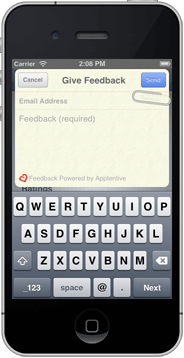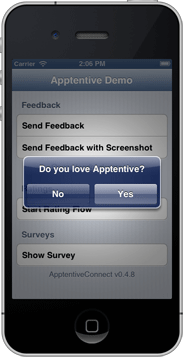7.8 KiB
Apptentive iOS SDK
This iOS library allows you to add a quick and easy in-app-feedback mechanism to your iOS applications. Feedback is sent to the Apptentive web service.
Quickstart
There are no external dependencies for this SDK.
Sample Application
The sample application FeedbackDemo demonstrates how to integrate the SDK with your application.
The demo app includes the normal feedback flow, which can be activated by clicking the Feedback button. It's a one screen process which can gather feedback, an email address, and even a screenshot:
The rating flow can be activated by clicking on the Ratings button. It asks the user if they are happy with the app. If not, then a simplified feedback window is opened. If they are happy with the app, they are prompted to rate the app in the App Store:
Required Frameworks
In order to use ApptentiveConnect, your project must link against the
following frameworks:
- CoreGraphics
- CoreTelephony
- Foundation
- QuartzCore
- StoreKit
- SystemConfiguration
- UIKit
Project Settings for Xcode 4
The instructions below are for source integration. For binary releases, see our Binary Distributions page.
There is a video demoing integration in Xcode 4 here: http://vimeo.com/23710908
Drag the ApptentiveConnect.xcodeproj project to your project in Xcode 4 and
add it as a subproject. You can do the same with a workspace.
In your target's Build Settings section, add the following to your
Other Linker Flags settings:
-ObjC -all_load
In your target's Build Phases section, add the ApptentiveConnect and
ApptentiveResources targets to your Target Dependencies.
Then, add libApptentiveConnect.a to Link Binary With Libraries
Build the ApptentiveResources target for iOS devices. Then, add the
ApptentiveResources.bundle from the ApptentiveConnect products in the
file navigator into your Copy Bundle Resources build phase. Building
for iOS devices first works around a bug in Xcode 4.
Now, drag ATConnect.h from ApptentiveConnect.xcodeproj to your app's
file list.
Now see "Using the Library", below, for instructions on using the library in your code.
Using the Library
ApptentiveConnect queues feedback and attempts to upload in the background. This
is intended to provide as quick a mechanism for submitting feedback as possible.
In order for queued/interrupted feedback uploads to continue uploading, we
recommending instantiating ATConnect and setting the API key at application
startup, like:
#include "ATConnect.h"
// ...
- (void)applicationDidFinishLaunching:(UIApplication *)application /* ... */ {
ATConnect *connection = [ATConnect sharedConnection];
connection.apiKey = kApptentiveAPIKey;
// ...
}
Where kApptentiveAPIKey is an NSString containing your API key. As soon
as you set the API key on the shared connection object, any queued feedback
will start to upload, pending network availability. You also should not have
to set the API key again on the shared connection object.
Now, you can show the Apptentive feedback UI from a UIViewController with:
#include "ATConnect.h"
// ...
ATConnect *connection = [ATConnect sharedConnection];
[connection presentFeedbackControllerFromViewController:self];
Easy!
App Rating Flow
ApptentiveConnect now provides an app rating flow similar to other projects
such as appirator. This uses the number
of launches of your application, the amount of time users have been using it, and
the number of significant events the user has completed (for example, levels passed)
to determine when to display a ratings dialog.
To use it, add the ATAppRatingFlow.h header file to your project.
Then, at startup, instantiate a shared ATAppRatingFlow object with your
iTunes app ID (see "Finding Your iTunes App ID" below):
#include "ATAppRatingFlow.h"
// ...
- (void)applicationDidFinishLaunching:(UIApplication *)application /* ... */ {
ATAppRatingFlow *sharedFlow = [ATAppRatingFlow sharedRatingFlowWithAppID:@"<your iTunes app ID>"];
// The parameter is a BOOL indicating whether a rating dialog can be
// shown here.
[sharedFlow appDidLaunch:YES viewController:self.navigationController];
// ...
}
- (void)applicationDidBecomeActive:(UIApplication *)application {
ATAppRatingFlow *sharedFlow = [ATAppRatingFlow sharedRatingFlowWithAppID:@"<your iTunes app ID>"];
[sharedFlow appDidEnterForeground:YES viewController:self.navigationController];
}
The viewController parameter is necessary in order to be able to show the
feedback view controller if a user is unhappy with your app.
If you're using significant events to determine when to show the ratings flow, you can increment the number of significant events by calling:
[sharedFlow userDidPerformSignificantEvent:canPromptForRating viewController:aViewController];
Above, canPromptForRating is a BOOL indicating whether the user could be prompted for a rating then and there, and aViewController is a UIViewController from which to display the feedback view controller if the user is unhappy with your app.
You can also choose to show the dialog manually:
ATAppRatingFlow *sharedFlow = [ATAppRatingFlow sharedRatingFlowWithAppID:kApptentiveAppID];
[sharedFlow showEnjoymentDialog:aViewController];
This is helpful if you want to implement custom triggers for the ratings flow.
You can modify the parameters which determine when the ratings dialog will be shown in your app settings on apptentive.com.
Metrics
Metrics provide insight into exactly where people begin and end interactions with your app and with feedback, ratings, and surveys. You can enable and disable metrics on your app settings page on apptentive.com.
Surveys
To use surveys, add the ATSurveys.h header to your project.
You can check for available surveys after having set up ATConnect (see above)
by calling [ATSurveys checkForAvailableSurveys] and registering for the
ATSurveyNewSurveyAvailableNotification notification. Then, you may present a
survey by calling [ATSurveys presentSurveyControllerFromViewController:vc],
where vc is the view controller which will present the survey.
For example:
#include "ATSurveys.h"
// ...
- (void)applicationDidFinishLaunching:(UIApplication *)application /* ... */ {
// ...
[[NSNotificationCenter defaultCenter] addObserver:self selector:@selector(surveyBecameAvailable:) name:ATSurveyNewSurveyAvailableNotification object:nil];
[ATSurveys checkForAvailableSurveys];
}
- (void)surveyBecameAvailable:(NSNotification *)notification {
// Present survey here as appropriate.
}
Finding Your iTunes App ID In iTunesConnect, go to "Manage Your Applications" and click on your application. In the "App Information" section of the page, look for the "Apple ID". It will be a number. This is your iTunes application ID.
Contributing
We love contributions!
Any contributions to the master apptentive-ios project must sign the Individual Contributor License Agreement (CLA). It's a doc that makes our lawyers happy and ensures we can provide a solid open source project.
When you want to submit a change, send us a pull request. Before we merge, we'll check to make sure you're on the list of people who've signed our CLA.
Thanks!

